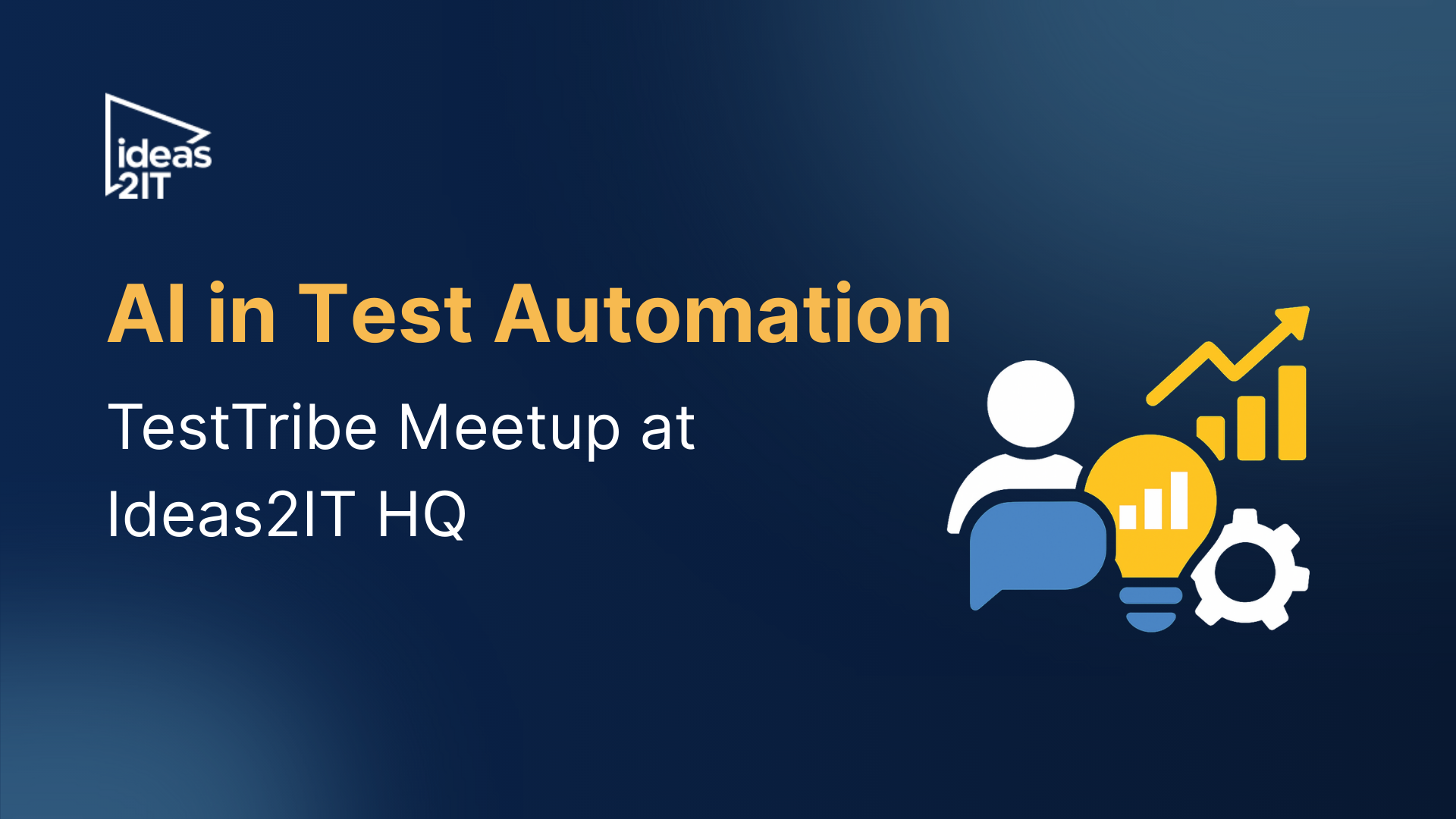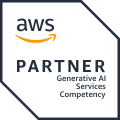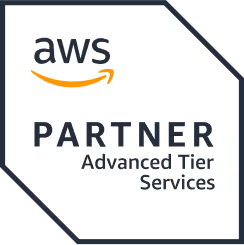AI Safety in Healthcare: Moving Beyond Trust to Measurable Guardrails
TL'DR
- AI adoption in healthcare is accelerating, with nearly two-thirds of physicians now using AI-enabled tools in clinical or operational workflows.
- Safety maturity hasn’t kept pace while most organizations still lack measurable frameworks to govern bias, drift, or decision accountability.
- “Trust” is base minimum need. What healthcare needs now are testable guardrails that make AI performance auditable and reproducible.
- Key safety guardrails include:
- Maker–checker AI agents for dual validation of automated actions
- Human-in-the-loop (HITL) review for all high-impact decisions
- Audit logs and explainability layers for traceability and compliance
- Phased rollouts with performance gates and rollback triggers
- The risks of skipping safety rigor: compliance penalties, patient harm, and irreversible loss of clinician confidence.
- Ideas2IT helps payers and providers operationalize safe, production-grade AI systems that are traceable, explainable, and regulator-ready enabling AI at velocity with measurable assurance.
The promise of artificial intelligence in healthcare has never been greater. From diagnostic support and treatment planning to payer claims automation and patient-intake optimisation, AI holds the potential to transform care delivery, reduce cost and unlock entirely new workflows.
Yet, this promise comes with paradoxes. On one hand, clinician adoption is accelerating, reflecting demand for smarter tools. On the other, significant gaps remain in validation, governance and operational safety.
In regulated industries such as aviation and finance, systems are certified, audited and tightly controlled before deployment. Healthcare AI, by contrast, is still playing catch-up.
This blog argues that trust is no longer sufficient. Trust may open the door, but it doesn’t guarantee safety or effectiveness. What’s required instead is a shift toward measurable, provable guardrails built from design through deployment that healthcare leaders can rely on. These guardrails are foundational for scaling AI safely in mission-critical care settings.
In what follows we will:
- Review the current state of AI safety in healthcare what the data reveals about validation gaps and risk.
- Define what measurable guardrails look like in practice.
- Illustrate the cost of getting it wrong.
- Provide a four-step operational playbook for embedding safety.
- Show how Ideas2IT’s differentiated approach is already helping payers and providers move beyond pilot-phase AI to full-scale, safe, production systems.
The Real State of AI Safety in Healthcare
AI in healthcare is entering its next phase: from algorithmic breakthroughs to operational integration. What began as isolated pilots, detecting anomalies in images, triaging claims, predicting risk is now finding its way into real clinical and administrative workflows. And with that shift, the safety conversation is changing.
Rather than asking “Is this AI accurate?”, healthcare leaders are now asking:
- “Is it reliable across different populations and contexts?”
- “Can it be audited and explained?”
- “Do we have oversight when it acts unexpectedly?”
These are questions about systems maturity.
From Research Excellence to Operational Readiness
In the research setting, AI systems often perform under tightly controlled conditions: well-curated data, defined endpoints, and expert oversight. But hospital floors and payer operations are far less predictable.
Real-world healthcare introduces variability in patient populations, data quality, workflow complexity, and human interpretation. A model that performs well in a benchmark study may behave differently when integrated with an EHR that’s five versions behind or when faced with missing demographic data.
The shift from scientific performance to operational reliability is where many AI initiatives stall because guardrails aren’t yet codified.
The Oversight Challenge
Regulators and health systems are both evolving to address this gap.
- The FDA’s AI/ML Action Plan and its emerging Predetermined Change Control Plan (PCCP) framework aim to bring continuous learning systems under structured oversight.
- The WHO’s guidance on ethics and governance of AI for health recommends a “safety by design” approach, embedding human oversight and traceability from development through deployment.
- And initiatives like FUTURE-AI and NIST’s AI Risk Management Framework are giving developers practical toolkits to operationalize trustworthiness and robustness.
These frameworks all converge on one idea: safety is a lifecycle. It must be built, monitored, and measured continuously, just as infection control or drug safety is.
Where Healthcare Leaders Stand Today
Most hospitals, payers, and life-science firms are past the experimentation stage. They have working proofs of concept and early wins but few have formalized AI safety governance into their production environments.
A 2024 Deloitte survey found that while 70 % of healthcare executives consider “responsible AI” a strategic priority, fewer than 20 % have measurable guardrails or internal safety frameworks in place.
That’s a moment of transition. The next wave of healthcare AI will be less about capability and more about control:
- Building measurable oversight loops.
- Embedding explainability and auditability.
- Defining success in terms of safety metrics, not just accuracy metrics.
This is the maturity gap we’ll address in the next sections: how to move from “trusted but unverified” AI to “measured, monitored, and safe” AI.
The Trust Trap
Every healthcare AI success story begins with trust, a clinician willing to believe that an algorithm can assist. That leap of faith has powered hundreds of pilots across radiology, oncology, and population health.
But as these systems move from controlled pilots to daily clinical operations, trust alone stops being a safety net. It’s not that clinicians don’t believe in AI, it’s that belief isn’t enough when patient outcomes, compliance, and liability are at stake.
When “Trust” Becomes a Bottleneck
Most AI pilots in healthcare succeed because of champion users, physicians who nurture adoption within a team. Yet when these tools expand to other sites or departments, their reliability is tested against far more diverse data, workflows, and patient populations.
In this transition, unquantified trust quickly becomes fragility. A Deloitte survey showed that while two-thirds of clinicians have tried AI tools, the majority still rate “lack of transparency” and “limited oversight” as top blockers to routine use. Trust erodes when results can’t be verified, when model logic is opaque, or when errors surface without clear accountability.
Learning from Other Regulated Industries
Other high-stakes sectors learned long ago that trust must be engineered.
- Aviation uses deterministic testing and fail-safe redundancy before any autopilot enters a cockpit.
- Finance mandates audit trails and model explainability to comply with trading and credit regulations.
- Pharma validates molecules through controlled trials before human exposure.
Why Blind Trust Fails at Scale
A few years ago, an AI imaging model designed to detect intracranial bleeds performed exceptionally in its pilot hospital but mis-classified dozens of cases when deployed across new scanners and demographics. Because the algorithm encountered unseen data drift.
The episode underscores a simple truth: trust that isn’t measurable doesn’t scale.
Once clinicians see AI produce unsafe or inexplicable results, regaining their confidence takes months of retraining and re-validation. As one CMIO recently put it, “AI doesn’t get a second first impression.”
The Next Standard: Proof Over Belief
To evolve from experimental adoption to institutional reliability, healthcare must move from subjective trust to objective assurance.
- Trust is emotional; assurance is evidential.
- Trust relies on user faith; assurance relies on measurable safety signals.
- Trust is earned once; assurance is maintained continuously.
Healthcare AI will mature the same way aviation and pharma did through measurable guardrails that make trust auditable. That shift defines the future of safe, scalable AI adoption.
From Trust to Testable Safety
If “trust” is the first phase of AI adoption in healthcare, testing is the second and the one that determines whether AI can scale safely.
The good news: healthcare doesn’t need to reinvent what safety means. The frameworks already exist from the FDA’s Predetermined Change Control Plan (PCCP) to NIST’s AI Risk Management Framework. What’s missing is their operationalization inside real workflows. In other words: we know how to define safety. The challenge is learning how to measure it continuously, transparently, and at system scale.
Why Measurement Matters More Than Belief
A radiology model that’s 94 % accurate in one cohort and 76 % in another isn’t “unsafe”, it’s uncalibrated. A claims automation system that approves most requests correctly but can’t explain its outliers isn’t “malicious”, it’s ungoverned.
Without metrics, both cases force leaders to rely on anecdotal confidence instead of quantifiable assurance.
Healthcare AI’s next frontier, therefore, is measurable reliability, systems that can report, not just predict. The shift mirrors how clinical trials evolved from “does this drug work?” to “for whom, how often, under what conditions?”
From Qualitative Trust to Quantitative Guardrails
This is what separates a responsible pilot from a governed production system.
The Core Tenet of Testable AI Safety
Safety in healthcare AI must be demonstrated. That means establishing quantifiable checkpoints across the model lifecycle:
- Pre-Deployment:
- Clinical scenario simulation
- Bias and adversarial testing
- Approval thresholds tied to confidence scores
- In-Production:
- Drift detection and performance decay alerts
- Layered human validation for high-risk decisions
- Audit logs for traceability and compliance review
- Post-Deployment:
- Continuous feedback loops from clinicians
- Model re-training with monitored change controls
- Transparent reporting to regulators and governance boards
Each of these steps turns AI from a “black box” to a glass box that is auditable, explainable, and accountable.
What This Means for Healthcare Leaders
The most mature healthcare organisations are now treating AI systems like medical staff: privileged to act, but subject to credentialing, supervision, and ongoing review.
Just as a new surgeon must demonstrate competency under supervision before operating independently, AI models must prove reliability under controlled guardrails before scaling across populations.
This measurable approach stabilizes innovation. It’s the bridge between experimentation and enterprise reliability, and it’s where true ROI begins.
What Measurable Guardrails Look Like
In healthcare, safety is an architecture. Trustworthy AI systems don’t depend on belief; they’re designed with measurable control points that make safety observable and auditable at every stage of operation.
Below are the four guardrails that transform AI from “assistive but uncertain” to “governed and dependable.”
1. Maker–Checker AI Agents
Every automated decision in healthcare , whether approving a prior authorization or flagging a diagnostic image must have a counterbalance.
A maker–checker model achieves that.
- One agent (maker) proposes an action based on a model’s output.
- A second agent (checker) validates it against pre-defined policy, clinical guidelines, or safety thresholds before execution.
In payer operations, for example, a maker–checker loop ensures an AI-driven claim approval aligns with policy and compliance rules before release. In clinical support systems, it prevents premature AI recommendations from bypassing human verification.
This dual-agent design creates a structured second opinion, algorithmic redundancy that mirrors peer review in medicine.
2. Human-in-the-Loop (HITL) Validation
No AI system should operate autonomously in life-impacting workflows. HITL models embed human expertise directly into decision chains:
- AI handles the initial inference- triaging, summarizing, or proposing.
- A clinician, pharmacist, or analyst reviews, edits, or overrides before final action.
This ensures that critical tasks like treatment plan generation, diagnostic triage, or drug interaction alerts always have clinical accountability.
HITL also serves as a natural data-quality feedback loop. Every correction improves future model retraining, making the system safer over time rather than riskier.
3. Audit Logs + Explainability Layers
Safety isn’t real unless it’s provable. Every AI decision from data input to model inference to output must leave a digital footprint.
- Audit logs capture time-stamped records of what was recommended, who validated it, and what data it was based on.
- Explainability layers (e.g., SHAP, LIME, or domain-tuned visual explanations) translate those inferences into clinician-readable rationales.
Together, these create algorithmic traceability. If a regulator audits a care-automation workflow or a compliance team investigates a misclassification, every decision is reviewable.
In short: auditability transforms “trust me” AI into “show me” AI.
4. Phased Rollouts with Safety Metrics
The final guardrail is procedural. Instead of deploying AI across entire enterprises, mature healthcare systems now follow phased rollouts:
- Sandbox testing: AI runs in parallel to human workflows, without influencing outcomes.
- Limited cohort: Small subset of users or departments tests live integration.
- Measured expansion: Only after sustained performance against safety metrics (accuracy, recall, error-rate ceilings) does the rollout scale.
This approach mirrors clinical trials for software, progressive exposure with measurable checkpoints. It reduces the risk of model drift, reveals edge-case failures early, and builds clinician trust through demonstrated consistency.
What These Guardrails Enable
Together, these mechanisms convert AI from an experimental asset to an operationally certified system.
They enable three outcomes essential for healthcare adoption:
- Regulatory readiness — every action traceable, auditable, and explainable.
- Clinician confidence — every recommendation reviewed or verified by human expertise.
- Sustainable scaling — every new deployment stage anchored by measurable safety KPIs.
Guardrails make innovation repeatable. And in healthcare, repeatability is safety.
The Cost of Getting It Wrong
In healthcare, AI failure is consequential when algorithms influence diagnoses, authorizations, or interventions, errors ripple through systems that directly touch human lives.
The challenge is that without safety scaffolding, small mistakes scale fast.
1. Compliance Violations That Stall Progress
Every healthcare organization deploying AI operates under a dense web of regulation HIPAA, CMS, FDA SaMD, and the EU’s AI Act equivalents for global providers.
An algorithm that mishandles protected data, auto-approves an unqualified claim, or alters a clinical decision without traceability can trigger serious violations.
- HIPAA penalties can reach $1.5 million per year per violation category.
- FDA non-compliance can force product recalls or submission holds, delaying commercialization for months.
- CMS audit failures can suspend payment streams or trigger claw-backs.
Each of these doesn’t just cost money, it freezes innovation. Teams stop building until they can explain what went wrong.
2. Patient-Safety Risks That Erode Trust
The biggest cost of unsafe AI is it’s clinical. Without validation loops, an algorithm can quietly amplify bias or drift over time:
- A diagnostic model trained primarily on one demographic misses anomalies in under-represented groups.
- A triage system optimizes for throughput and deprioritizes rare but critical conditions.
- An automation tool approves coverage based on incomplete historical data.
In each case, the system works perfectly according to its logic and dangerously according to ours.
The result is delayed diagnoses, inappropriate interventions, or overlooked red flags errors that directly impact patient outcomes and expose providers to litigation.
3. Erosion of Clinician Confidence
AI adoption thrives on clinician buy-in and dies when trust is broken. Once a tool is perceived as unreliable, even statistically strong models struggle to regain credibility.
At the 2024 HIMSS survey, more than 70 % of physicians said they would abandon an AI tool after one unsafe or inexplicable outcome.
Loss of confidence has cascading effects:
- Clinicians revert to manual workarounds, negating efficiency gains.
- Compliance teams tighten oversight, slowing iteration cycles.
- Innovation budgets get redirected to risk remediation instead of progress.
Trust, once lost, doesn’t regenerate on the next software patch.
Why Prevention Outperforms Remediation
Each of the previous sections adds up to a simple economic truth: safety is an ROI multiplier.
A guardrail-first architecture prevents:
- Regulatory fines through traceability
- Patient harm through validation
- Rework through transparency
- Adoption friction through confidence
Building measurable safety upfront costs less than retrofitting it after an incident and positions healthcare organizations to scale AI confidently instead of cautiously.
The 4-Step Playbook for Operationalizing Safety
For AI to mature from pilot to production, safety must be systematized. This playbook outlines four steps healthcare leaders can use to move from experimentation to measurable, regulated-ready AI operations.
Step 1: Start with Low-Risk Operational Use Cases
AI adoption shouldn’t begin where patient lives depend on it. The safest proving grounds are operational workflows that combine high data volume with low clinical risk:
- Claims and prior-authorization automation
- Eligibility verification and coding assistance
- Appointment optimization and patient outreach
These early wins help teams test governance processes, benchmark model reliability, and tune feedback loops without exposing core clinical decisions to algorithmic risk. Success here builds the operational muscle memory for future high-stakes use cases.
Step 2: Design for Safety from Day One
Most AI failures trace back to guardrails added after deployment. Embedding safety early means codifying it in the model-development lifecycle itself:
- Bias and robustness testing: Validate on demographically diverse and adversarial datasets.
- Scenario simulation: Stress-test edge cases and outlier data patterns before launch.
- Fail-safe defaults: Define what the system should do when uncertain.
- Traceability hooks: Log every inference and decision path automatically.
By building for transparency and human control at the architecture level, you prevent downstream safety debt and the hidden cost of retroactive governance.
Step 3: Layer Oversight Intelligently
Not all oversight is created equal. Mature AI operations layer supervision at multiple levels:
Together, these create multiple lines of control that make AI predictable, explainable, and reviewable.
Step 4: Roll Out in Controlled Phases
Treat AI deployment like a clinical trial: expand exposure only when safety metrics hold.
- Sandbox Phase – AI runs silently in parallel to human workflows; metrics are tracked, but outputs don’t influence real decisions.
- Limited Cohort Phase – A subset of departments or clinicians use AI in production with defined fallback protocols.
- Progressive Scale-Up – System expands enterprise-wide only after sustained accuracy, auditability, and clinician satisfaction thresholds are met.
Making the Playbook Work
Each rollout teaches the next, each validation informs retraining, and each audit tightens oversight. When executed well, this cycle transforms AI from a risky experiment into a regulated asset, one that scales responsibly, survives scrutiny, and sustains clinician confidence.
Why Ideas2IT is Ahead of the AI Curve
Most health systems are still experimenting with pilots. The difference is that Ideas2IT is already helping payers and providers deploy production-grade AI systems anchored in measurable safety.
- Proven track record → We’ve built and deployed oncology decision-support systems, payer claims automation, and patient intake agents all with HITL oversight and auditable logs.
- Guardrails-first approach → Every implementation embeds accuracy checks, bias testing, and phased rollouts from day one.
- Domain + engineering depth → Our teams combine healthcare workflow knowledge with deep AI engineering, ensuring solutions work in the real-world context of providers and payers.
That’s why health systems choose us: while vendors are still selling roadmaps, we’re delivering outcomes safely in production.
How Ideas2IT Stays Ahead of the AI Curve
Healthcare AI is moving fast but our teams move faster. Ideas2IT invests in:
- Early adoption of breakthroughs → From Snowflake to agentic AI frameworks, we build competencies before they hit mainstream.
- In-house accelerators → Platforms like LegacyLeap for modernization and our internal QA automation stack let us validate and scale faster than off-the-shelf tools.
- Continuous upskilling → 750+ engineers undergo structured AI-native training, ensuring delivery teams bring tomorrow’s methods into today’s projects.
- Silicon Valley DNA + Healthcare depth → We pair startup-speed innovation with deep payer and provider domain expertise.
This is why clients trust us: while the market is still running pilots, we’re already delivering enterprise-scale AI systems with safety, velocity, and measurable ROI.
AI safety in healthcare is about measurable control. The organizations that win will be those who embed guardrails from day one, prove ROI in low-risk areas, and scale with confidence.
Ideas2IT helps payers and providers do exactly that. Book a consultation with our AI Healthcare team to explore how we can build your AI strategy safely, at scale.







.png)
.png)
.png)
.png)
.png)













